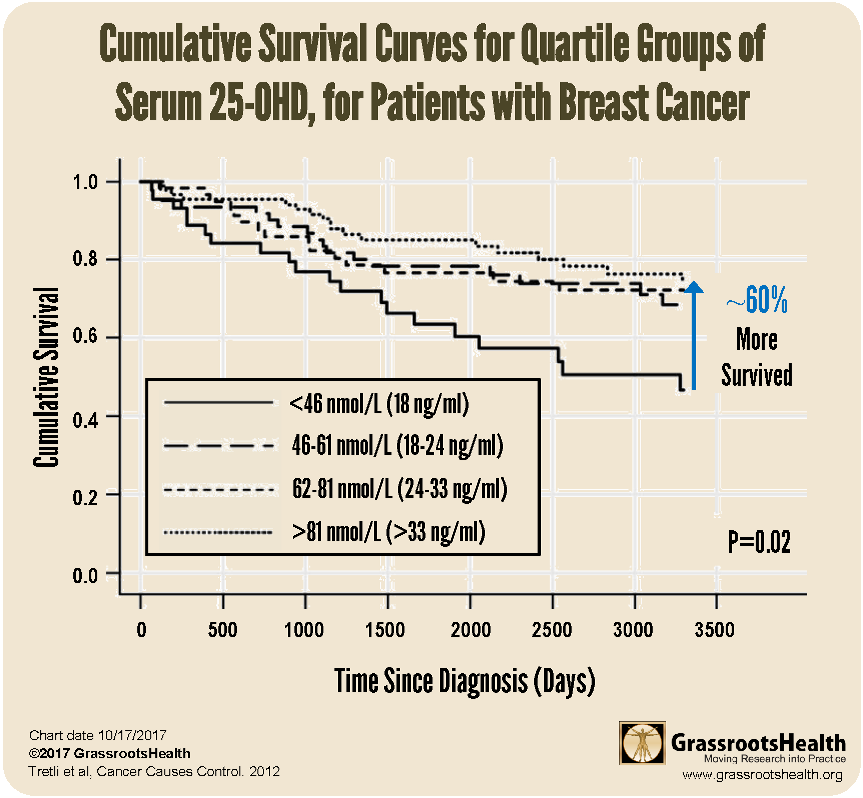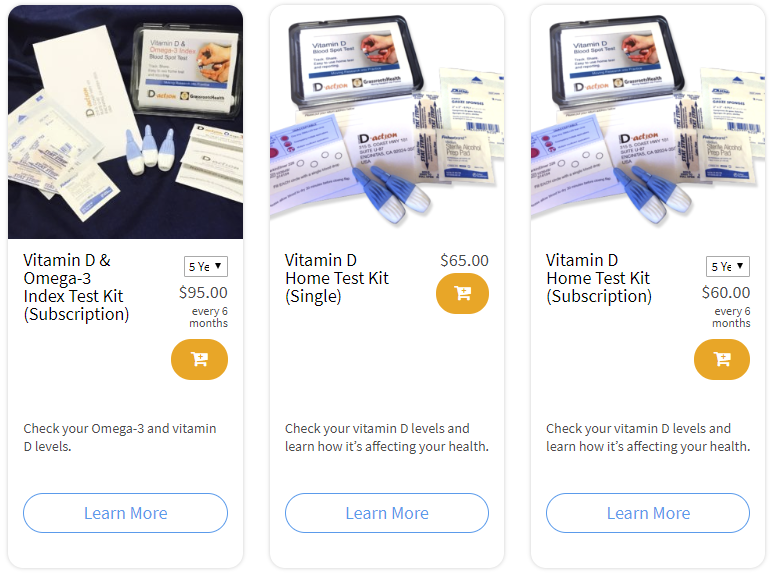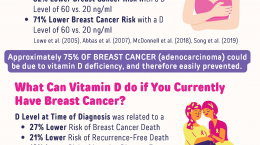Published on October 25, 2019
 October is Breast Cancer Awareness Month, but here at GrassrootsHealth Nutrient Research Institute we prefer to take the opportunity each October to focus on breast cancer prevention. To help educate the public on the effects of vitamin D and breast cancer prevention, we have created a series of posts focused on key research, with highlights from the first randomized controlled trial published on vitamin D and cancer, a second study that replicated those findings, and another using data from two cohorts to show a 71% reduction in the risk of cancer. Our last post featured a study published with data combined from the Lappe cohort and the GrassrootsHealth cohort, which indicated that having a level of at least 60 ng/ml of vitamin D may have additional benefits for risk reduction of breast cancer. Today we highlight one more study looking at vitamin D and breast cancer survival.
October is Breast Cancer Awareness Month, but here at GrassrootsHealth Nutrient Research Institute we prefer to take the opportunity each October to focus on breast cancer prevention. To help educate the public on the effects of vitamin D and breast cancer prevention, we have created a series of posts focused on key research, with highlights from the first randomized controlled trial published on vitamin D and cancer, a second study that replicated those findings, and another using data from two cohorts to show a 71% reduction in the risk of cancer. Our last post featured a study published with data combined from the Lappe cohort and the GrassrootsHealth cohort, which indicated that having a level of at least 60 ng/ml of vitamin D may have additional benefits for risk reduction of breast cancer. Today we highlight one more study looking at vitamin D and breast cancer survival.
Please share this informational series with all you know who may have or be concerned with getting breast cancer.
Vitamin D may help increase breast cancer survival rate by 60%
Tretli et al. studied 658 Norwegian patients diagnosed between 1984 and 2004 with breast cancer, colon cancer, lung cancer or lymphoma. Blood levels of 25(OH)D were determined within 90 days of diagnosis, and subjects were followed until 2008. The analysis divided patients into four vitamin D groupings of roughly equal size and plotted survival over time for each of the groups.
The following chart illustrates their findings for breast cancer survival. Notice the highest survival rate is achieved by the group with the highest vitamin D level, over 33 ng/ml (81 nmol/L).
Additional findings from this research study show increased survival rates for lung cancer, colon cancer, and lymphoma.
Join the Study to Help Reduce Breast Cancer Incidence
Reduce Breast Cancer NOW! is a field trial of GrassrootsHealth using our methodology for moving nutrient research into practice. This model was developed and tested over 7 years, with over 10,000 participants, through the D*action project. All women can join this project to help demonstrate the effects of vitamin D on breast cancer prevention.
Donate to this project today!
Are you concerned about your vitamin D level and cancer?
Testing your vitamin D level regularly and taking steps to keep it at a target level of 40-60 ng/ml (100-150 nmol/L) is important for all stages of health. Through GrassrootsHealth Nutrient Research Institute, you can also test your omega-3 status, inflammation levels, and levels of essential nutrients and toxins. Find out your levels today! Log on to the shop (click the link below) to get your tests and see for yourself if your level can be improved.
Make sure you track your results before and after, about every 6 months!
Click Here to Access the Shop Page
How can I track my nutrient intake and levels over time?
To help you track your supplement use and nutrient levels, GrassrootsHealth Nutrient Research Institute has created an online tracking system called myData-myAnswers. For each specific supplement, you can track what days you take it, how much, and many other details. This will help you know your true supplemental intake and what patterns of use work for you to reach and maintain optimum nutrient levels. Check it out today!








